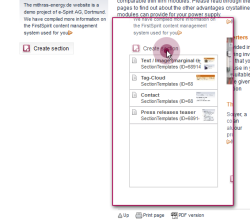Interactive Features
Client interface plug-ins enhance usability by providing project-specific, interactive features. Each of these plug-in types ties into a different area in the WebClient user interface and is able to handle FirstSpirit data as well as poll input from users.
1. InlineEdit Items Plug-In
InlineEdit item plug-ins insert one or more actions into the button overlay that appears as the mouse pointer hovers over a section, page contents or data records rendered in the preview pane. The button actions work within the context of the FirstSpirit element they are associated with (e.g. a section for which an InlineEdit frame is displayed).
Developer API documentation: WebeditInlineEditItemsPlugin
InlineEdit items provided by this plug-in type may implement the following functionality:
- Executable
implements a clickable button. On click, the class' executable method is called.
Developer API documentation: ExecutableInlineEditItem - Client Script Provider
implements a clickable button. On click, a class method is called upon to provide JavaScript code which will be executed in the client interface.
Developer API documentation: ClientScriptProvidingInlineEditItem
2. Template Buttons (FS_BUTTON)
Using the input component FS_BUTTON, template designers and project developers can provide access to scripts and Java classes that implement extra functionality. These buttons are placed directly in page, section or data record templates, may handle click and drag-and-drop interactions, and can be rendered in forms, preview/generated representations of elements or both.
FS_BUTTON instances
- work within the context of the object associated with the template in which the button was defined
- are able to call scripts and Java classes that perform custom functionality and may create dialogs, message boxes and lists
- are able to react to both click and drag-and-drop operations
3. Toolbar Menu Items Plug-In
Toolbar menu items plug-ins may specify one or more menu items which will be shown in the Actions menu of the WebClient toolbar. Individual items operate within the context of the FirstSpirit element currently shown in the preview pane of the client interface.
Developer API documentation: WebeditToolbarActionsItemsPlugin
A toolbar menu items plug-in can provide one or more items of the following types:
- Executable
implements a clickable menu item. On click, the class' executable method is called.
Developer API documentation: ExecutableToolbarActionsItem - Client Script Provider
implements a clickable menu item. On click, a class method is called upon to provide JavaScript code which will be executed in the client interface.
Developer API documentation: ClientScriptProvidingToolbarActionsItem
4. Reports
Custom reports may display specific sets of objects - including FirstSpirit store elements and objects obtained from other data sources such as web services - and provide filtering, sorting and data management capabilities. Individual report objects can be used as data sources for drag-and-drop operations in conjunction with FS_BUTTONs placed in page previews.
Developer API documentation: WebeditReportPlugin
Reports
- work within the context of the entire project, but can optionally poll for the page reference currently displayed in the preview and update list contents as the user navigates the project
- are able to include and work with FirstSpirit objects as well as content from outside sources
- are able to serve as a source for drag-and-drop data (based on objects listed in the report)
The report plug-in itself instantiates and passes to WebClient two further objects of the following interfaces:
- Data Provider
collects and returns objects that should be included in a report's result list, based on the current filter configuration.
Developer API documentation: ReportPluginProvider - Renderer
implements rendering functionality for each object shown in a result list (e.g. title, abstract and thumbnail).
Developer API documentation: ReportPluginRenderer
5. Element Status and Workflow Grouping Plug-Ins
This plug-in type specifies a project-wide algorithm to determine the page status (whether it is considered released, modified or currently in a workflow) that is displayed in the WebClient toolbar. It may also provide groups of pages, page references and media elements that users may place into workflows together as a batch operation.
Developer API documentation: WebeditElementStatusProviderPlugin
Element status display and workflow grouping plug-ins
- operate within the context of the page reference that is currently displayed in the preview pane
- optionally assemble groups of objects related to the current preview--using the page reference object as a point of origin--that WebClient will use to identify available workflows
 |
Note that page status and workflow grouping plug-ins should implement read-only functionality; they are not intended to modify store content or create interactive features. |






